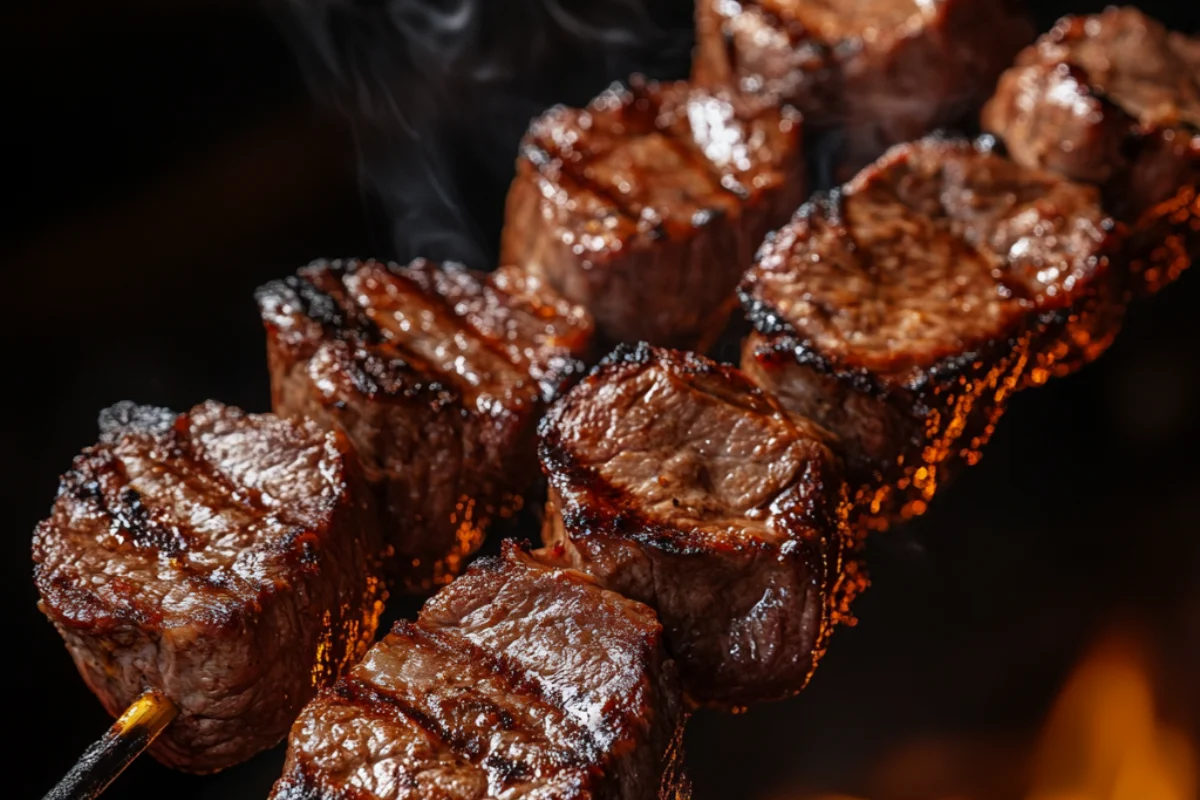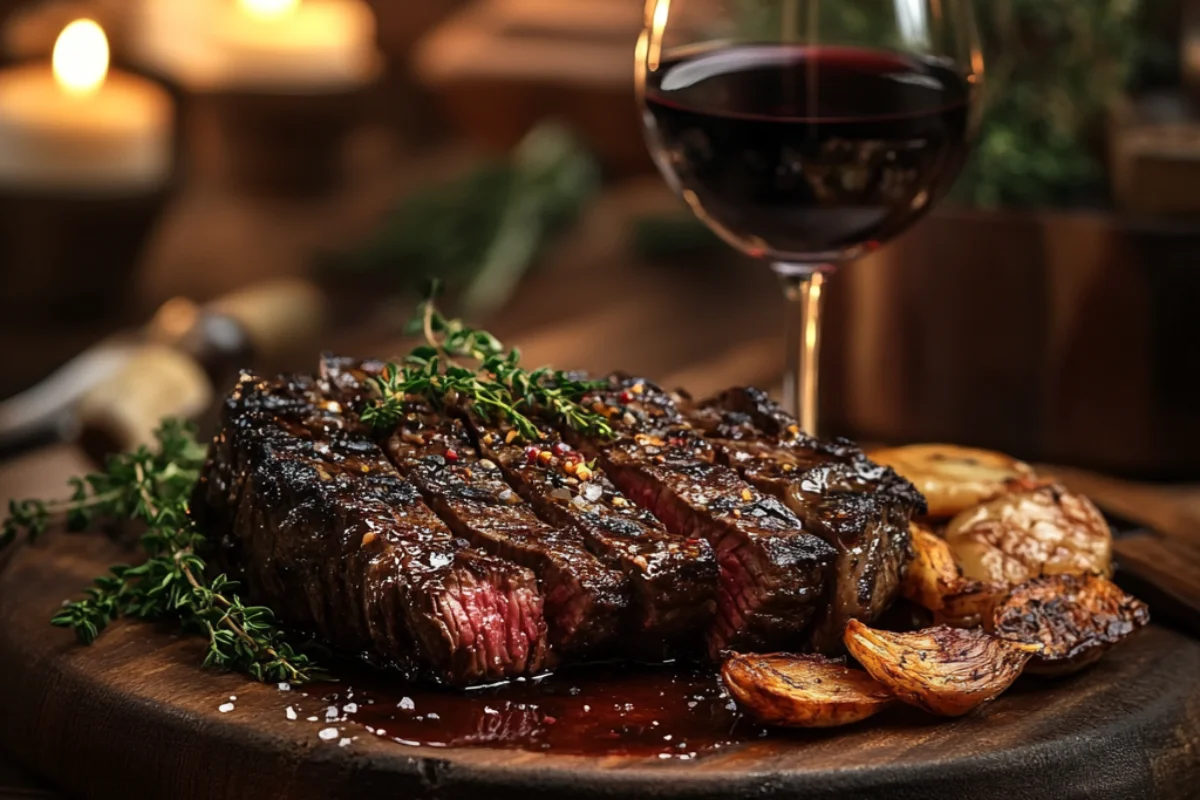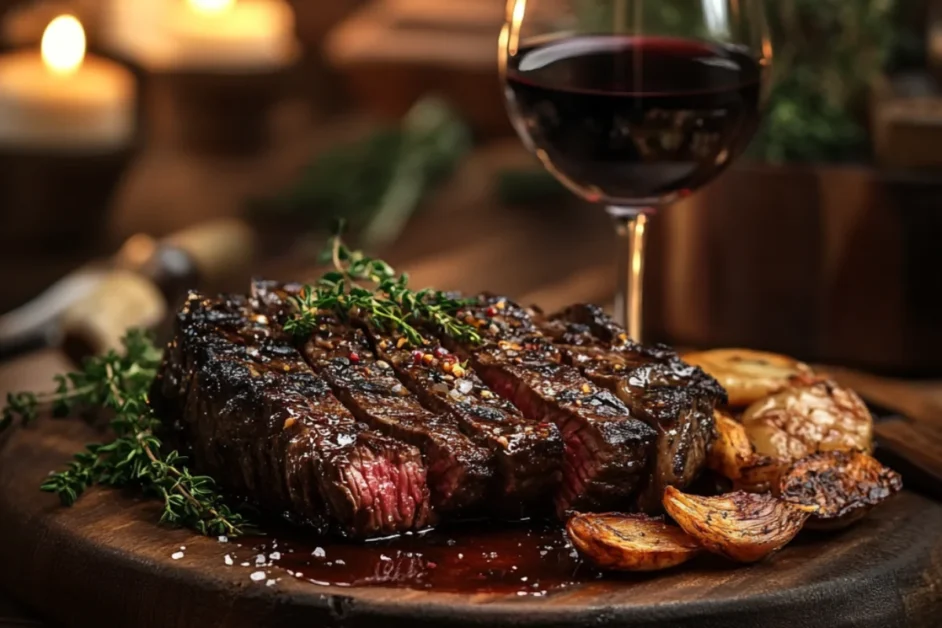A Comprehensive Guide to Picanha Steak: Brazilian Cuisine’s Crown Jewel
1. Introduction to Picanha Steak

What is Picanha?
Picanha steak is a distinctive cut of beef, cherished for its tender texture and bold flavor. Sourced from the rump cap or top sirloin cap, it is identified by its thick fat cap, which enhances flavor and moisture during cooking. Unlike other cuts, picanha is usually sliced into steaks or grilled whole, retaining its fatty richness.
Origin and Cultural Significance
This cut holds a special place in Brazilian barbecue culture, also known as churrasco. Its roots trace back to traditional South American ranching practices, where simple, flavorful cooking methods were vital. Today, it is an integral feature at Brazilian steakhouses, or churrascarias, and serves as a symbol of communal gatherings and celebration.
Why Picanha is a Favorite in Brazilian Cuisine
- Rich Flavor: The thick fat cap renders beautifully when grilled, creating an unmatched flavor profile.
- Versatility: Whether cooked over charcoal or seared on a pan, picanha adapts to various cooking styles.
- Cultural Heritage: For Brazilians, serving picanha is synonymous with hospitality and festivity.
This unique blend of taste, tradition, and versatility ensures picanha remains a favorite on every Brazilian grill.
2. Choosing the Right Cut of Picanha
Understanding Picanha’s Unique Cut
The picanha cut is located at the top of the rump, sitting above the sirloin and close to the hip. Key characteristics include:
- Triangular Shape: A compact, tapered cut with a rounded base.
- Fat Cap: A distinctive, even layer of fat covering one side.
This specific cut is often mislabeled or overlooked outside Brazil, making it important to know how to identify it.
How to Identify Quality Picanha at the Butcher
When selecting picanha, look for:
- Size: A proper picanha cut should weigh between 1-1.5 kilograms (2-3 pounds).
- Marbling: Fine streaks of intramuscular fat ensure tenderness and flavor.
- Fat Cap: A uniform, creamy-white fat layer without discoloration.
- Label: If labeled “rump cap” or “top sirloin cap,” verify it’s not trimmed down too much.
Alternatives if Picanha is Unavailable
If you can’t find authentic picanha, consider these substitutes:
- Tri-Tip: Similar in texture but lacks the signature fat cap.
- Sirloin Steak: Another flavorful cut, although leaner.
- Flat Iron Steak: A well-marbled alternative for grilling.
While these cuts lack the traditional experience of picanha, they still deliver excellent results when properly prepared.
3. Preparing the Picanha for Cooking
Trimming the Fat Cap: Do You Need to?
The fat cap is what makes picanha so special, but there’s some debate over whether to trim it:
- Traditionalists: Keep the fat cap intact for flavor and moisture retention.
- Moderate Approach: Trim only excess fat, leaving about 0.5 inches for rendering.
- Preference-Based: If you’re cooking for those wary of fatty textures, a slight trim can make the dish more approachable.
Properly Seasoning the Meat
Unlike heavily spiced dishes, picanha thrives on simplicity:
- Use coarse salt liberally to coat the meat.
- Add cracked black pepper for extra depth if desired.
- Avoid complex marinades, which can mask the beef’s natural flavors.
Pro tip: Allow the meat to absorb the seasoning for at least 30 minutes before cooking.
Allowing Time for the Meat to Rest Before Cooking
Resting is a crucial step that enhances tenderness:
- Before Cooking: Let the meat come to room temperature, ensuring even cooking.
- After Cooking: Rest the meat for 5-10 minutes post-grilling to lock in the juices.
Skipping this step can result in uneven textures or a dry steak.
4. Tools and Equipment for Cooking Picanha
Recommended Grills, Pans, and Knives
The right tools can elevate your picanha experience:
- Grill: A charcoal grill is preferred for authentic Brazilian churrasco. Gas grills or pellet smokers are suitable alternatives.
- Cast Iron Pan: Ideal for indoor cooking, providing even heat distribution.
- Knives: Use a sharp carving knife to slice through the fat cap cleanly.
Must-Have Accessories for a Perfect Picanha Experience
To enhance your cooking process, consider:
- Meat Thermometer: Essential for monitoring internal temperatures.
- Skewers: Brazilian-style skewers help achieve that authentic churrasco experience.
- Basting Brush: Handy for applying rendered fat or marinades during cooking.
Alternative Cooking Methods
If you don’t have a grill, try:
- Oven Roasting: Roast at high heat to replicate grilling.
- Sous Vide: Perfect for precise cooking, followed by a quick sear.
- Smoker: For a slow-cooked, smoky flavor.
Each method delivers unique textures and flavors, allowing you to experiment based on available tools.
5. Traditional Brazilian Grilling Method for Picanha
Preparing a Charcoal Grill
A traditional churrasco relies on charcoal grilling:
- Light the Charcoal: Use a chimney starter for even heat distribution.
- Create Heat Zones: Arrange coals to provide both direct and indirect heat.
- Preheat the Grill: Allow the grates to reach optimal temperature before cooking.
Skewering and Grilling Techniques
Brazilian skewering involves folding picanha into a horseshoe shape:
- Slice the meat into thick strips (around 1-2 inches).
- Fold each strip, fat side out, into a crescent.
- Secure the pieces onto large skewers.
Grill the skewers over direct heat, turning frequently to ensure even cooking and a crisp fat cap.
Monitoring Temperature for Optimal Results
Proper temperature management is essential for tender picanha:
- Medium Rare: 130°F (54°C) internal temperature.
- Medium: 140°F (60°C).
- Avoid overcooking, as it can dry out the meat.
When done, remove the skewers and rest the meat before slicing thinly against the grain.
Mastering the Art of Cooking Picanha: Techniques, Tips, and Perfect Pairings
6. Oven-Roasting Picanha: A Step-by-Step Guide
When and Why to Choose Oven Roasting
Oven-roasting picanha is an excellent choice when:
- Outdoor Grilling Isn’t an Option: Weather constraints or lack of a grill.
- Large Cuts: A whole picanha fits well in the oven, allowing even cooking.
- Convenience: Minimal supervision compared to grilling.
This method ensures even heat distribution while preserving the meat’s tenderness.
Preheating and Setting the Right Temperature
Follow these steps for a perfectly roasted picanha:
- Preheat the Oven: Set to 400°F (200°C) for a crisp exterior or 325°F (165°C) for slower cooking.
- Season Generously: Apply salt and optional spices across the surface.
- Use a Wire Rack: Elevating the meat ensures even airflow and prevents sogginess.
Tips for Keeping the Meat Tender and Juicy
- Start Fat Side Up: Allow the fat to render and baste the meat naturally.
- Baste Regularly: Use a basting brush to apply rendered fat or juices every 15 minutes.
- Monitor Temperature: Remove at 130°F (54°C) for medium-rare or 140°F (60°C) for medium.
- Rest the Meat: Let it sit for 10 minutes to redistribute juices before slicing.
7. Reverse Searing Technique for Picanha
What is Reverse Searing?
Reverse searing involves slow-cooking the meat first and finishing it with a high-heat sear. This method ensures:
- Even cooking throughout the steak.
- A crispy, caramelized crust without overcooking the interior.
Detailed Steps to Achieve a Perfect Sear
- Prepare the Meat: Season the picanha and let it come to room temperature.
- Cook Slowly: Roast in an oven or indirect grill heat at 250°F (120°C) until the internal temperature reaches 120°F (49°C).
- Heat a Skillet or Grill: Use high heat to create a scorching-hot surface.
- Sear Quickly: Place the meat fat-side down first, flipping after 1-2 minutes per side for a golden-brown crust.
Common Mistakes to Avoid
- Skipping Resting Time: Allow the meat to rest after slow cooking to avoid uneven cooking.
- Over-Searing: Monitor the crust carefully to prevent burning.
- Not Using a Thermometer: Ensuring accurate temperature is crucial for consistency.
8. Sous Vide Method for Cooking Picanha
Advantages of Sous Vide for Picanha
Sous vide offers unparalleled control over doneness by cooking the meat in a vacuum-sealed bag submerged in a temperature-controlled water bath. Benefits include:
- Precision: No risk of overcooking.
- Juiciness: Sealed cooking locks in moisture.
- Convenience: Requires minimal monitoring.
Time and Temperature Settings
For the perfect picanha, follow these guidelines:
- Medium-Rare: Cook at 130°F (54°C) for 2-3 hours.
- Medium: Cook at 140°F (60°C) for 2-3 hours.
- Tenderization: Extend cooking time to 4-5 hours for tougher cuts.
Finishing Touches: Searing After Sous Vide
After sous vide, a quick sear adds texture and flavor:
- Heat a cast iron skillet or grill to high heat.
- Sear fat-side down first for 1-2 minutes, then flip.
- Serve immediately for the best taste and texture.
9. Perfect Seasoning Blends for Picanha
Traditional Brazilian Seasoning: Salt and Garlic
- Coarse Sea Salt: Enhances the natural flavors of the beef.
- Garlic Paste: Adds depth without overpowering the meat’s profile.
Simply rub the garlic paste onto the meat, followed by a liberal coating of salt before cooking.
Creative Flavor Profiles
For a twist on the classic, try these seasoning blends:
- Spicy: Paprika, cayenne, and black pepper for a fiery kick.
- Smoky: Smoked salt and chipotle powder to complement charcoal cooking.
- Herb-Infused: Rosemary, thyme, and oregano mixed with olive oil for an aromatic crust.
How Marinades Impact Picanha
Marinades are less common with picanha, but if used sparingly, they can:
- Tenderize the meat.
- Infuse subtle flavors such as soy sauce, lime juice, or Worcestershire sauce.
Avoid overly acidic marinades that can break down the meat’s texture.
10. Serving Picanha: Sides and Accompaniments
Classic Brazilian Side Dishes
- Farofa: Toasted cassava flour mixed with bacon, onions, and herbs for a nutty, crunchy complement.
- Feijão Tropeiro: A hearty bean dish cooked with sausage, eggs, and collard greens.
- Vinagrete: A tangy tomato-onion vinaigrette that cuts through the richness of picanha.
These sides reflect the authentic Brazilian churrasco experience.
Modern Twists
For a contemporary spin, consider:
- Roasted Vegetables: Carrots, zucchini, and bell peppers for a colorful, healthy option.
- Chimichurri Sauce: A vibrant blend of parsley, garlic, olive oil, and vinegar to enhance every bite.
- Garlic Mashed Potatoes: Creamy, buttery mashed potatoes infused with roasted garlic for a luxurious pairing.
These accompaniments cater to a wider palate, making picanha the centerpiece of a diverse meal.
11. Tips for Cooking Picanha to Perfection
Key Temperature Guidelines:
- Internal Temperature for Picanha: To achieve the perfect doneness, use a meat thermometer to monitor the internal temperature. Here are the ideal temperatures:
- Rare: 120-125°F (49-52°C)
- Medium-Rare: 130-135°F (54-57°C)
- Medium: 140-145°F (60-63°C)
- Medium-Well: 150-155°F (66-68°C)
- Well-Done: 160°F (71°C) and above
- Resting: After cooking, let the picanha rest for about 5-10 minutes. This allows juices to redistribute, enhancing flavor and tenderness.
Understanding the Role of Resting the Meat:
- Resting allows the muscle fibers to relax and reabsorb some of the juices that have been driven out during cooking. This helps prevent the meat from being dry when cut. It’s crucial to rest picanha after grilling, especially if you’re cooking it to a higher temperature, to maintain its juiciness and tenderness.
Testing for Doneness Without Overcooking:
- Using a Meat Thermometer: This is the most reliable method for testing doneness without guessing. Simply insert the probe into the thickest part of the picanha (avoiding bone or fat) and check the temperature.
- Touch Test (for Grill Masters): If you prefer not to use a thermometer, you can use the “touch test.” Compare the firmness of the meat to the firmness of the fleshy area below your thumb (for rare, medium-rare, etc.). However, this method requires practice and experience to perfect.
12. Pairing Picanha with Drinks

Best Wines for Grilled Picanha:
- Red Wines are the best choice for picanha, thanks to their rich, bold flavors that complement the steak’s savory and smoky notes. Consider these options:
- Malbec: A deep red with bold tannins and dark fruit flavors that go well with the smokiness of the grilled meat.
- Cabernet Sauvignon: Its tannin structure and dark berry flavors cut through the richness of picanha, balancing the fattiness of the cut.
- Zinfandel: A fruit-forward wine with spice and smoky notes, it enhances the charred flavor of picanha.
- Syrah/Shiraz: Offers a peppery finish and deep fruit notes, complementing the seasoning and char of the meat.
Craft Beer Pairings:
- IPA (India Pale Ale): The bitterness of an IPA can help balance the richness of picanha, while the hoppy and citrusy flavors bring a refreshing contrast.
- Porter or Stout: A darker beer with roasted malt flavors can enhance the savory and umami qualities of the meat, providing a perfect contrast to its fattiness.
- Amber Ale: Slightly sweet, malty, and balanced with some bitterness, this beer complements the savory profile of picanha without overpowering it.
Non-Alcoholic Options:
- Iced Tea: A lightly sweetened or unsweetened iced tea with a slice of lemon provides a refreshing contrast to the richness of picanha.
- Sparkling Water: The bubbles and neutral taste cleanse the palate between bites of rich meat, making it an excellent choice.
- Virgin Mojito: The refreshing combination of mint and lime offers a zesty and cooling pairing with picanha, especially for those who prefer a non-alcoholic beverage.
13. Troubleshooting Common Issues with Picanha

Why is My Picanha Tough?
- Overcooking: If you cook picanha for too long, especially to a higher doneness (medium-well or well-done), it can become tough and dry. Always use a meat thermometer to avoid overcooking.
- Undercooking: Undercooked picanha can also be tough, particularly if it’s not allowed to rest. This results in chewy muscle fibers that haven’t had time to break down and relax.
- Poor Quality Meat: If you’re using a lower-quality picanha, it may not have the right amount of marbling, which contributes to tenderness. Always choose a well-marbled piece of meat for the best texture.
- Not Searing Properly: Searing on high heat is essential for locking in juices and creating a delicious crust. A lack of proper searing can result in a rubbery texture.
- Improper Slicing: Slice the picanha against the grain to avoid tough, chewy pieces. Always cut perpendicular to the muscle fibers to ensure tenderness.
By following these tips, you can ensure your picanha turns out perfectly every time, whether you’re grilling it for a special occasion or simply enjoying a delicious meal with family or friends.
Conclusion
Cooking picanha to perfection is an art that combines the right technique, temperature control, and the right pairings to enhance the natural flavors of the meat. By understanding key temperature guidelines, ensuring proper resting time, and using reliable methods to check for doneness, you can consistently achieve a tender, flavorful picanha that will impress your guests. Pairing picanha with the right drink, whether it’s a bold red wine, a refreshing craft beer, or a non-alcoholic option, elevates the entire dining experience. Troubleshooting common issues like overcooking or improper slicing will ensure that your picanha remains tender and juicy. Armed with these tips, you are now ready to make every picanha dish a flavorful masterpiece!
FAQ
1. What is the best way to cook picanha?
- The best method is to grill picanha, either on a skewer (Brazilian-style) or as steaks, using high heat to sear the meat and then reducing the heat to cook it to your desired doneness. Make sure to rest the meat after grilling.
2. Can I cook picanha in the oven?
- Yes, you can roast picanha in the oven, but grilling is preferred for the smoky flavor. To cook in the oven, sear the meat in a hot pan first, then roast at 400°F (200°C) until it reaches your desired internal temperature.
3. How do I know when my picanha is done?
- The most accurate way is to use a meat thermometer. For medium-rare, aim for an internal temperature of 130-135°F (54-57°C). Always allow the meat to rest for 5-10 minutes after cooking.
4. Why is my picanha too tough?
- Overcooking is usually the culprit. Make sure you cook the meat to the right temperature and allow it to rest after grilling. Toughness can also result from slicing it against the grain—always cut perpendicular to the muscle fibers.
5. What are some good side dishes to serve with picanha?
- Picanha pairs well with grilled vegetables, rice, beans, roasted potatoes, and a fresh salad. Brazilian sides like farofa (toasted cassava flour) and vinaigrette are traditional choices.

